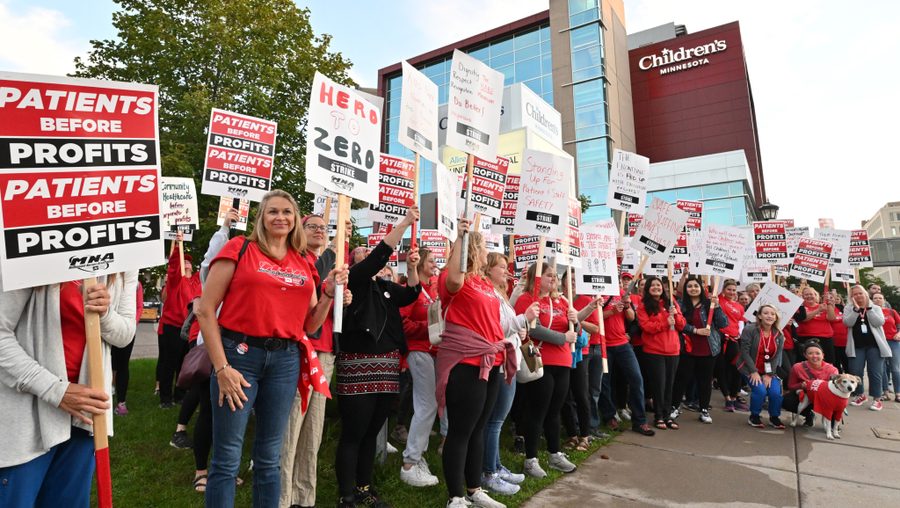In Minnesota, the Largest Private-Sector Nurses Strike in U.S. History
Protesting understaffing and low pay, Minnesota nurses hit the picket line in a “fight for our very profession.”
Sarah Lahm

For the past 14 years, Kelley Anaas, 37, has worked as a nurse at Abbott Northwestern Hospital in the Phillips community of Minneapolis, Minnesota. But on September 13, she traded in her scrubs and rubber clogs for comfortable walking shoes to join her fellow nurses on the picket line.
Claiming that nurses are continually being expected to go against their own moral compass while on the job, Anaas said that hospital administrators are corporatizing healthcare, in part by advising nurses to use “cookie cutter patient plans” rather than rely on their own expertise.
On Monday, September 12, around 15,000 nurses in Minnesota walked off the job for a three-day strike, citing staffing and safety concerns as well as ongoing contract disputes at 15 hospitals in the Twin Cities and Duluth metro areas.
The walk out is considered to be the largest private-sector nurses strike in U.S. history and comes at a time when nurses across the country are not only dealing with longstanding workplace challenges, but pushing back against them. A recent article in The Nation noted that there were “76 strikes in healthcare between January 2021 and mid-April 2022 alone,” as nurses navigate pre- and post-pandemic staffing, safety, and compensation issues with their employers.
Mary Turner is president of the Minnesota Nurses Association, which represents more than 22,000 nurses and healthcare professionals in the Upper Midwest. At a Monday press conference, Turner said nurses are in a “fight for our very profession,” as hospital administrators continue to put pressure on them to do more with fewer resources.
Turner described nurses being required to work shifts longer than 16 hours in some instances, in what she said was a retaliatory move from their employers who did not want nurses to go out and walk the picket line.
Another nurse, Melissa Cole, also spoke up at the press conference. Cole described how Children’s Hospital Minnesota St. Paul Campus, where she works, has lost more than 500 nurses in the past few years “due to the moral distress of no longer being able to provide the care and quality they believe your children deserve.”
Cole’s statement taps into a growing realization among frontline workers that they are experiencing what some researchers describe as “moral injury.” This term first arose in connection with Vietnam War veterans who were asked or required to commit atrocities on the battlefield, in violation of their own moral judgment and in the absence of real leadership or guidance.
Soldiers were often then “blamed or punished for their actions,” according to a recent In These Times exploration of the parallel between moral injury among both veterans and frontline workers, including nurses.
According to Anaas, hospital administrators are dictating how nurses do their jobs, even when it’s not in their patients’ best interests. “They’re practically sending us scripts to use at patients’ bedsides,” she said, “and handing out decisions” that are made off-site, with no accounting for nurses’ everyday challenges.
As a result, healthcare workers are experiencing exhaustion and burnout, but it’s really only the tip of the iceberg for nurses like Anaas. She described giving birth to two children during her years as a nurse, and in each instance, Anaas had to fund her own maternity leave by using up sick time and vacation days.
That’s because there is no paid family leave plan available to nurses at her hospital, which is managed by Allina Health, a regional, nonprofit healthcare provider whose CEO Lisa Shannon makes more than $1 million per year.
“We want Allina to make it worth it for us to stay in this profession for a lifetime,” Anaas said, rather than focus on recruiting more nurses without paying attention to the workplace issues that are causing so many to quit.
Anaas cites an example of this that many other industry observers have also pointed to: traveling nurses. She says many of her coworkers have left their jobs to become traveling nurses instead, as a way to make more money and have more control over their schedules.
While Anaas says she is grateful to have the help of such nurses in her workplace, she noted that traveling nurses are not unionized, thus threatening the overall bargaining power of those who have chosen to remain on site.
Nurses are currently asking for a 30 percent raise over three years, along with more input into staffing decisions and a greater emphasis on nurses’ ability to direct patient care using their own professional judgment.
Speaking outside Abbott Northwestern Hospital on Tuesday, Angela Becchetti, who is a nurse and a member of the union’s negotiating team, put the focus on patient care. “We are tired of our hospitals saying ‘we don’t have enough, there’s nothing I can do, that costs too much,’” she said, noting that it’s patients who are suffering while hospital administrators continue to rake in higher salaries.
Paul Omodt, spokesperson for the Twin Cities Hospital Group, which represents several of the hospitals where nurses are on strike, has said that nurses have refused to go to mediation to end their contract disputes. “Their choice is to strike. This strike is on the nurses,” he told the Washington Post.
Union representatives have refuted that claim, insisting hospitals have had plenty of time to take nurses’ proposals seriously in order to avoid the walk out. With or without a deal, nurses plan to end their strike at 7 a.m. on September 15.
Still, a key realization looms large for Anaas: “Hospitals don’t make money by having experienced nurses, yet having experienced nurses leads to greater patient and nurse satisfaction.”
Sarah Lahm is a Minneapolis-based writer and former English Instructor. She writes the Midwest Dispatch column for the Progressive magazine, and her work has appeared in other local and national outlets.







